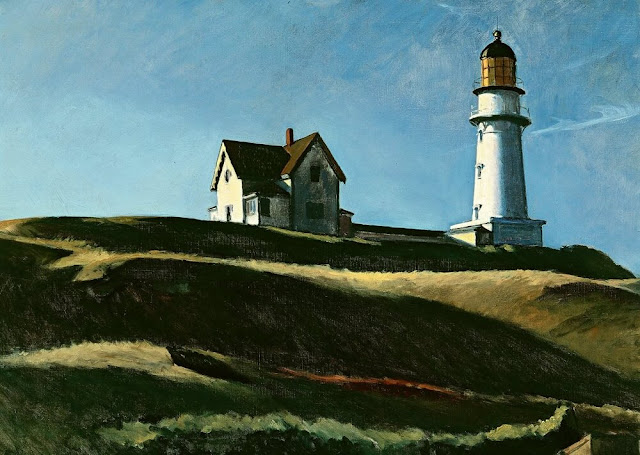
Lighthouse Hill, Edward Hopper, 1927
A Thought for the Day given during a lunchtime service of Holy
Communion at St Olave Hart Street on Tuesday 1st July 2025 based on the text of
Matthew 8.23–27.
Today, the superyachts berthed at St Katharine Docks are probably the closest we can get to imagining how busy the Port of London used to be – and not all that long ago. In the sixteenth century, as traffic on the waters increased so too did the number of accidents and shipwrecks.
A group of mariners from Deptford, themselves experienced in the dangers of life on the water, recognised the urgent need for greater regulation and safety, but they also wanted to offer care for aged and destitute sailors - those left behind weathered by the storms of life at sea. They petitioned King Henry VIII for permission to form a guild to address these needs.
Founded in 1514 it became what we now know as Trinity House. Over the
centuries it has built and maintained lighthouses and lightships – like the one
in the model just over there. They acted as beacons to protect mariners from
unseen dangers that lay beneath the waves or impossible to navigate in the
dark. The Guild was placed under the patronage of Saint Clement, the patron
saint of mariners—but it was named after ‘the Most Glorious and Undivided
Trinity’ – named after God himself - acknowledging that ultimately, safety at
sea lay not just in good seamanship, but in God’s hands.
For generations, sailors have placed their trust not only in their vessels or
the stars above, but in the lights and guidance provided by Trinity House -
whose headquarters are just down the road. Its work is commemorated in the
window of our own Trinity Chapel.
Long before Trinity House was founded, the ancient Norse Saga of Olaf Haraldsson, known to us as Saint Olaf, or Olave, reveals to us how the life of our Patron Saint was deeply connected to the sea.
The saga tells of a great storm that struck his fleet of Viking longships as they attempted to sail near Salten Fjord. The wind howled for days. The ships, lashed together, drifted helplessly. Progress was impossible. Panic must have gripped all aboard.
Olaf’s instinct was to turn to God for help. He called Bishop Sigurd aboard his ship. He placed a crucifix on the prow, read from the Gospels and sprinkled holy water over each vessel. The storm died down, the winds eased. The sea was not completely calmed - just enough to move forward in safety. The ancient poem describes the huge waves still looming over either side of the longships as they passed through the storm.
The story tells of the strength of Olaf’s faith and the power of God to bring order to chaos. And of course, it echoes another, older and more familiar story.
In our Gospel reading, we find Jesus in a boat with his disciples, caught in a sudden and fierce storm on the Sea of Galilee. Among the disciples are seasoned fishermen—those who knew the nuances of sailing on the lake; its moods, its dangers; the way the wind there can whip up the waves at a moments notice. Yet this storm terrifies them. “Lord, save us! We are perishing!” they cry out to Jesus while he sleeps.
“Why are you afraid?” Jesus asks them, when he wakes, “you of little faith?”
He stands, rebukes the wind and the sea—and the storm is stilled. The disciples are left speechless.
“What sort of man is this, that even the winds and the sea obey him?” they ask.
Even if we have never faced mortal danger at sea, like the disciples or Saint Olaf and his men - or the mariners who founded Trinity House, many of us know what it feels like to be caught in a storm. Perhaps the loss of someone dear. A sudden illness. A financial blow. A moment of crisis that leaves us feeling like we are sinking fast. These storms come without warning—or sometimes we see them approaching, but can do nothing to stop them. Either way, it can seem as though we too are perishing.
At such times, the familiar cry of the disciples becomes our own: “Lord, save us.”
Just as St Olave and the Deptford mariners, our
instinct is to reach out to God for protection in the hour of the storm. When
we feel overwhelmed, confused and gripped by fear.
“Lord save us” becomes our prayer.
Sometimes, as in the case of the disciples, he will bring a sudden end to the storm. In others, like St Olaf’s encounter with the storm on Salten Fjord or the lighthouses of Trinity House, he will offer a beacon, a passage through the chaos – just enough to get through.
While our instinct is to be more aware of the presence of our Saviour when we are wrought low, the gospel reminds us he is with us always.
How much greater will our hope and strength be to face the storms of life if we
remember this. Faith in our risen Saviour is the defeat of fear in all its
forms – and the key to freedom - to life the life of fullness that God intends
for each of us.
Image: Lighthouse Hill, Edward Hopper, 1927
.jpg)


No comments:
Post a Comment